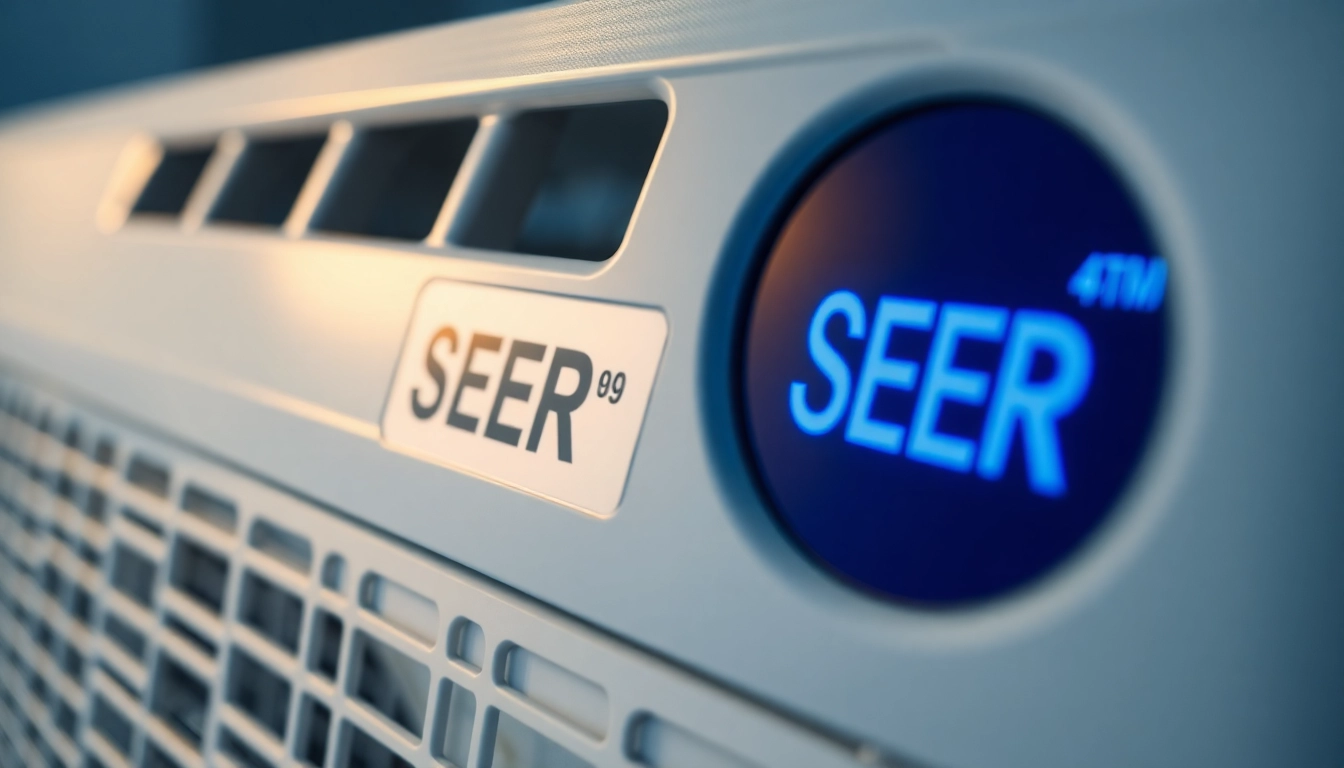What is SEER Rating in HVAC?
In the complex world of heating, ventilation, and air conditioning (HVAC), understanding efficiency ratings is crucial for homeowners and professionals alike. One key term that often comes up is the Seasonal Energy Efficiency Ratio, commonly referred to as SEER. This rating provides significant insight into the energy efficiency of air conditioning systems and heat pumps. Simply put, what is seer rating in hvac directly correlates with the cooling output and energy consumption of these systems.
Definition and Importance
SEER stands for Seasonal Energy Efficiency Ratio. It measures the cooling output of an air conditioning system, expressed in BTUs (British Thermal Units), over a typical cooling season, divided by the total electricity consumed in watt-hours. For example, if an air conditioning unit produces 24,000 BTUs over a cooling season while consuming 2,000 watt-hours, its SEER rating would be 12 (24,000/2000). As a benchmark for evaluating AC efficiency, the higher the SEER rating, the more energy-efficient the unit is perceived to be.
The importance of SEER ratings cannot be overstated. Higher SEER ratings indicate greater efficiency, which translates to lower energy bills and a reduced environmental footprint. Understanding SEER ratings helps consumers make informed decisions when purchasing air conditioning systems, as a higher SEER rating can lead to significant long-term savings.
Calculating SEER Ratings
Calculating the SEER rating involves understanding both the cooling output and the energy consumption of the HVAC system. The formula for SEER is:
SEER = Total Cooling Output (BTUs) / Total Energy Input (Watt-Hours)
This calculation considers the performance of the system during a typical cooling season, which usually spans the hottest months of the year. For more accurate measurements, the calculation adheres to specific testing standards set forth by the Air-Conditioning, Heating, and Refrigeration Institute (AHRI).
It’s important to note that SEER ratings can vary based on the environment, usage patterns, and system conditions. Therefore, the actual performance of an air conditioning unit can differ from its rated efficiency under different circumstances.
Difference Between SEER and EER
While SEER is a valuable metric for evaluating cooling efficiency over an entire season, another important efficiency metric is the Energy Efficiency Ratio (EER). EER measures the cooling output of an air conditioning unit at a specific temperature condition (typically at 95°F) and divides it by the electricity consumption at the same temperature.
The key difference lies in the applicability: SEER provides an average efficiency for various conditions throughout the cooling season, while EER reflects performance during peak heat. Understanding both ratings is crucial, especially in climates with extreme temperature fluctuations.
Why Does SEER Rating Matter?
Energy Efficiency and Cost Savings
Investing in an energy-efficient HVAC system with a higher SEER rating can lead to substantial cost savings on energy bills. For instance, an air conditioner rated at 16 SEER is approximately 13% more efficient than a 14 SEER unit. This difference can equate to significant annual savings, particularly in areas that experience long, hot summers.
When purchasing a system, homeowners should consider the initial costs versus the potential savings in energy bills over the system’s lifespan. Investing a bit more upfront for a higher SEER-rated unit can result in lower overall operating costs, which is financially advantageous in the long run.
Environmental Impact
Another compelling reason to opt for a higher SEER rating is its positive impact on the environment. Energy-efficient systems consume less electricity, which leads to a reduction in greenhouse gas emissions. Many regions are increasingly focused on sustainability, encouraging the use of HVAC systems that minimize environmental footprints.
As energy consumption decreases, reliance on fossil fuels is reduced, contributing to a more sustainable future. By choosing higher SEER-rated units, homeowners play a role in promoting eco-friendly practices and supporting efforts to combat climate change.
Regulatory Standards
In the U.S., regulatory bodies such as the Department of Energy (DOE) have set minimum efficiency standards for HVAC systems. These standards have evolved over the years to promote higher efficiency ratings. For example, as of January 1, 2023, the SEER2 standard was introduced, raising the minimum efficiency requirements, thus benefitting consumers through improved system efficiency and energy savings.
Understanding these regulations can guide consumers in choosing units that fulfill both government standards and their efficiency expectations. Moreover, they encourage manufacturers to innovate and improve upon existing technologies, further fueling advancements in HVAC systems.
How to Choose an HVAC System Based on SEER
Understanding SEER Ratings in Different Models
When selecting an HVAC system, understanding how SEER ratings apply across different brands and models is essential. Each manufacturer has a range of models with varying SEER ratings, and while higher ratings are generally preferable, it’s crucial to assess which models fit individual needs and budgets.
For example, a home in a milder climate might not need the highest SEER-rated units, while areas with extreme heat may warrant investing in a premium efficient air conditioning system. Additionally, some models can provide superior performance at lower SEER ratings due to features like improved airflow dynamics and enhanced insulation.
Evaluating Your Home’s Cooling Needs
Choosing the right HVAC system based on SEER ratings also necessitates evaluating your home’s specific cooling needs. Factors such as the home’s size, layout, insulation quality, and local climate conditions play a significant role in determining the most suitable SEER rating.
Homeowners should conduct an energy audit and consider consulting with HVAC professionals to assess how much cooling capacity is required for their spaces. An appropriately sized and rated system will contribute to both comfort and efficiency, ensuring that energy is not wasted in overcompensation.
Long-term Benefits of Higher SEER Ratings
Beyond immediate cost savings, investing in a higher SEER-rated HVAC system holds numerous long-term benefits. These include lower maintenance costs, improved reliability, and extended system lifespan. Higher efficiency tends to correlate with reduced wear and tear on system components, minimizing the likelihood of costly repairs.
Additionally, homes equipped with high-SEER systems often see higher resale values. Potential buyers recognize the appeal of an energy-efficient home, translating to better market competitiveness. Thus, higher initial investments in HVAC systems can yield enriched property value over time.
Common Misconceptions about SEER Ratings
Higher SEER Equals Better Quality?
A common misconception is that a higher SEER rating guarantees overall better quality. While energy efficiency is a crucial factor, it’s only one aspect of the system’s performance. Factors like the system’s build quality, brand reputation, warranty offers, and installation quality must also be considered.
It’s vital to evaluate systems holistically, speaking with licensed professionals who can provide insights into reliable brands and models that offer both efficiency and longevity.
Misunderstanding SEER Ratings Over 20
Another misconception revolves around systems boasting SEER ratings over 20; many consumers assume these systems will disproportionately lower energy bills. However, while higher ratings generally correlate with better efficiency, the actual savings can vary based on several variables, including usage habits and regional energy prices.
Hence, while a unit with a 25 SEER rating is impressive, ensure it fits your specific needs and is suitable for your environment to guarantee practical savings.
SEER Ratings and Actual Performance
It’s essential to recognize that advertised SEER ratings may not always reflect real-world performance. Many factors such as installation quality, system maintenance, and even user habits can affect efficiency.
Proper installation by certified technicians is critical, as errors can significantly diminish the expected performance. Regular maintenance can also keep units operating at their optimal efficiency levels, maximizing the benefits of higher SEER ratings.
Future of SEER Ratings in HVAC Industry
Upcoming Regulations and Changes
The HVAC industry is undergoing significant changes as regulatory standards evolve to prioritize energy efficiency. The introduction of SEER2 reflects newer testing methods that more accurately represent real-world performance, highlighting the industry’s movement towards more rigorous standards.
Continued changes in regulations will likely require manufacturers to innovate and exceed current SEER standards, paving the way for more efficient technologies and offering consumers superior options that not only enhance efficiency but contribute to environmental goals.
Innovation in HVAC Technology
Innovation in HVAC technology will continue to shape the industry’s future. Smart thermostats, energy management systems, and advancements in refrigerants will provide a robust framework for improving energy efficiency. These innovations will help consumers monitor and optimize their energy use, contributing to not only cost savings but sustainability efforts.
As systems become smarter and more adaptable to individual user needs, homeowners will have access to increasingly sophisticated methods to enhance their home’s efficiency and performance, effectively offering personalized cooling solutions.
SEER2 and Its Implications
SEER2 is the new iteration of the SEER rating, improving upon the original method by factoring in the efficiency of the unit’s blower and other components, considered critical under varying operational conditions. This change marks a significant step to enhance accuracy, allowing consumers to make better-informed choices when selecting HVAC systems.
As the industry adapts to this and other changes, it is anticipated that SEER2 ratings will bring even higher efficiency standards, further pushing the envelope for energy conservation and performance in HVAC systems.



